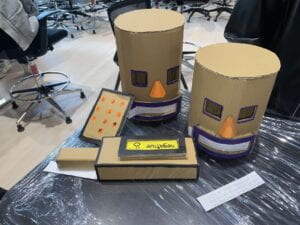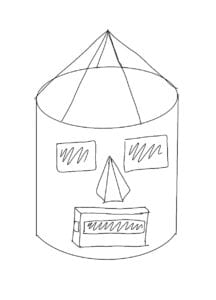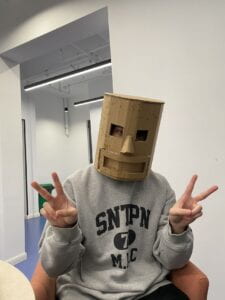Group Research Project: Report
Group 11 – Crows: Tu Quynh, Kelvin, Yoon, Fay, Rain
During the first meeting with the group members, we all shared our ideas of artifacts for each story. From there, we decided that it would be most interesting to build an artifact based on the story of the Plague. In specific, Kelvin’s artifact was the most interesting to recreate and bring to life. He discussed his idea of a mask with captions that allow for others who struggle with hearing to adequately communicate. At first, we decided to replicate a face mask, however, it was better to make an entire helmet with more functionality. We also initially wanted to use the helmet for the infected people, who were stone and could only move in slow motion, however, we realized that it would be more effective for the crows to use it. The helmet functions as it detects what the user is saying, and conveys the message physically at the mouth part where others can read what the crows are saying. Because the helmet is also heavy and thick, there are mechanisms that allow for the users to hear more clearly inside. The ability to transmit thoughts efficiently while accommodating to those experiencing hearing loss is extremely important. Since those infected can only use their eyes, they are also able to read what the crows are saying to them, and can understand what is going on. We also added in another artifact, the detector, which scans people to see if they are positive or negative for the infection. For instance, people who are in a vegetated state could be mislabeled as infected, so this new technology was created in order to fix this detrimental issue.

I believe that the both the helmet and the detector are quite successful artifacts as they function the way they were implied to. The helmet has functions of sound amplification and caption creators; it also helps protect the crows from the viral infection. Some potential drawbacks of this helmet is that it does not show facial expressions of the crows, so they may seem not to be empathetic towards the people they encounter. Because of its heavy and bulky design, it may also be a little hard to breathe in, and if the user does not speak clearly or has a heavy accent, the captions may not correctly transmit what they are saying. Regarding the detector, it works by analyzing the person and seeing whether or not they are infected with the stone disease, or if they are just in a vegetated state and cannot move. It only detects for the stone disease, and nothing else. A potential drawback would be that it fails to detect properly after a certain amount of time it is used. Long-term, it could have malfunctions and not work accurately.

At first we were going to make a mask that was on the bottom half of the face. However, cardboard is quite bulky and difficult to use to make specific things, so we decided it would be more effective to create a helmet, both for our storyline and the method of fabrication. After the first helmet was successful, we then made a duplicate of it. We then added another artifact, the detector, which the design was quite simple as we thought of those detector sticks security people at the airports use. For the captions, it was a great idea to make an open box with slits on the side for ease of access in putting in the paper slips, and pulling them out. The same idea was used for the detector as we had positive or negative feedback. I personally worked mostly on the cardboard artifacts because I have had prior experience in creating things out of cardboard.
From the group document: The Plague spread virally around the world. People have to wear protection suits to protect themselves from being infected. However, the protection suit forms a physical barrier in people’s daily conversations. Especially the elders, many of them have tinnitus, which makes it harder for them to communicate with each other. And the decrease in the immune system makes them have a higher possibility to be infected, Hence, we plan to design a helmet that has detection, protection, and communication features all in one. We plan to insert a sensor within the helmet to detect the verbal information of the user. Then, the helmet will translate those verbal signals into textual information and project the information on the shield of the helmet. Also, the microphone inserted in the helmet can get sound signals. The sound amplifier inside the helmet can make sounds more clear. This design may help those elders and people with hearing disabilities to better express their ideas and reduce misunderstandings in daily conversations. To protect the user from being infected, there’s a radar transmitter attached to the helmet. It will detect the infected person by sending radar signals and receiving signals. Once the helmet detects the infected person, the helmet will release disinfectant matter externally.
Performance of Door-ry
The performance of the group using the magical door was incredibly fun to watch and their artifacts were also quite interesting. Their theme related to the story of the Veldt, which is why their main artifact was the magical transportation door. They had different artifacts and sets for each “place” they went to, and through their skit, they were able to convey the purpose of the door and what was going on in the story. The main actor was very natural with her acting, which made it very fun to watch. It starts off with her using her cardboard laptop to create a portal, which can be entered through the door. She would input where she wanted to visit on her laptop, and the magical door would take her there. They had props for each place the main character would travel to, for example, when she wanted to go to the bottom of the ocean, there was nemo, a shark, and other fish. Their artifacts were incredibly creative and made the entire performance interesting and comprehensible. I believe that they meet the criteria of the assignment and my only suggestion would be to decorate the magical door a little bit more.

Our team decided to meet a little later than most teams because our schedules were not aligned and we could not find a time that worked for everyone. When we finally met up, we discussed what to build and which storyline we were going to come up with. We decided that two people would work on the script, while the rest of us worked on the cardboard artifacts. We used wechat to communicate with each other to get clarifications on the script and the design. On the final day of our meeting, we decided to make another helmet in addition to the one we already created, and we also made a detector to use as another artifact. Half of us worked on the cardboard making while the other half wrote the captions for the helmets and painted on details. We all rehearsed a couple of times to get our performance right and split up the work adequately.
Script:
Actors: Narrator (TQ), 2 “crows” (Yoon & Fay), an old man (Kelvin), a vegetative person (Rain)
Scene 1
Narrator: The plague has swept the city. It’s highly contagious, hard to detect, and has no cure. The effects have been devastating. In order to minimize infections, the Emergency Management Institution has issued protective suits, but they are not always effective or convenient. For instance, the suits can only physically segregate each other without any functions to sterilize. And for the elders who suffer from hearing loss, the heavy and airtight suit makes it even harder for them to communicate with each other. These weaknesses and non-inclusivity of protective suits lead to a tragedy …
(two crows knock on the door)
(the old man opens the door)
Crow 1: At the request of our superiors, we’ve come here to check if anyone is infected in this residential district.
The old man: Sorry, I can’t really hear you. I’m 80 y/o now. I have been suffering from hearing loss for more than ten years. This heavy protection suit makes it almost impossible for me to talk with other people.
(the crow raises his/her voice and with some gestures)
Crow 2: We’re here to see if anyone is infected. We’ll just go around your house. If everything’s fine, we’ll leave. OK??
(two crows ignore the old man and rush into the house)
The old man: Wait! What are you doing? This is my house! Get out of here!
(two crows spot the old man’s son, who is a vegetative person)
Crow 1: Seems like we’ve already found one infected guy. Let’s move him outside.
(two crows start moving the old man’s son)
The old man: What are you doing? Leave my son alone. He’s disabled. He’s a vegetative person!
Crow 1: Then give me his ID. Let me check it in the disability information base.
(the old man frowns)
The old man: First of all, I can’t hear what you’re saying. Second of all, I don’t care what you’re saying. Just leave my son alone! He’s disabled!
(Two crows have eye contact and tacitly move the old man’s son outside)
Crow 2: Sorry, we’re just doing our job. If he can’t move, talk, or physically react to the outside world, we assume he is infected.
Scene 2
Narrator: However, if they put the smart helmets on, this tragedy won’t happen.
(two crows knock on the door)
(the old man opens the door)
Crow 1: At the request of our superiors, we’ve come here to check if anyone is infected in this residential district.
(the old man carefully reads the caption projected on the shield)
The old man: Oh sure! You can come inside.
(two crows walk inside)
Crow 1: Look! Is he infected? It seems like he can’t move.
(crow 2 scans the boy)
Crow 2: My radar detector shows that he’s not infected.
(the old man reads the caption)
The old man: This is my son. He ran into a severe car accident two years ago. The doctor said he would be in a persistent vegetative state forever. So he can’t react to the outside world anymore.
Crow 2: Sorry to hear that! Can you tell me his ID number so that we can check it in the disability information base?
The old man: Sure. It’s 12345678.
Crow 2: Got it! He’s in the information base. Hope you can stay safe during this pandemic. Take care!
The old man: Thank you! Bye!
